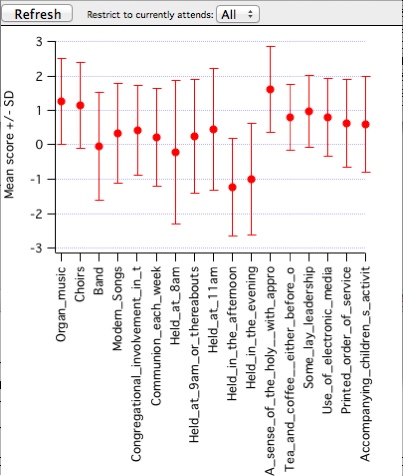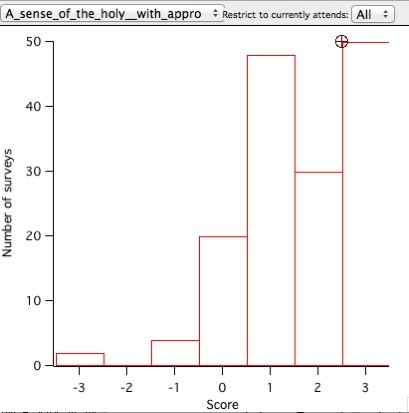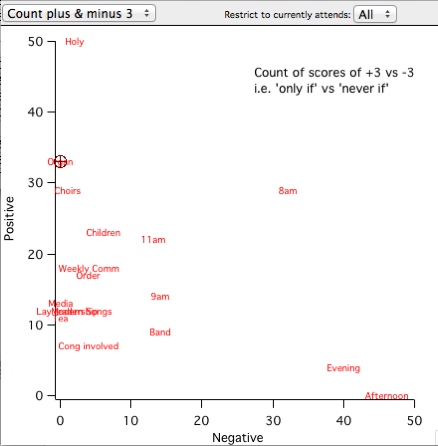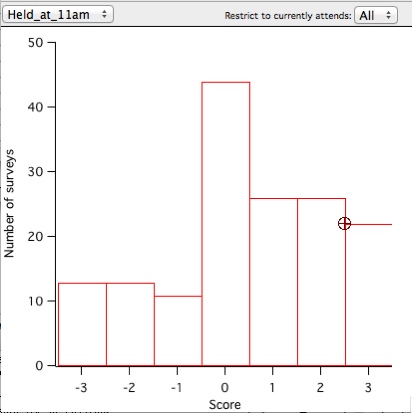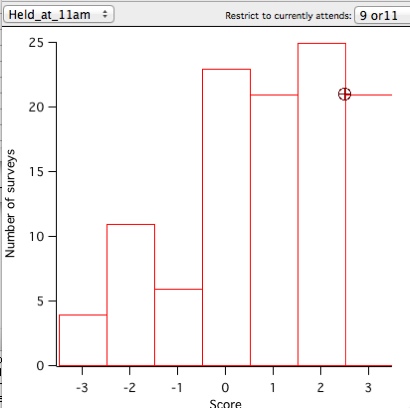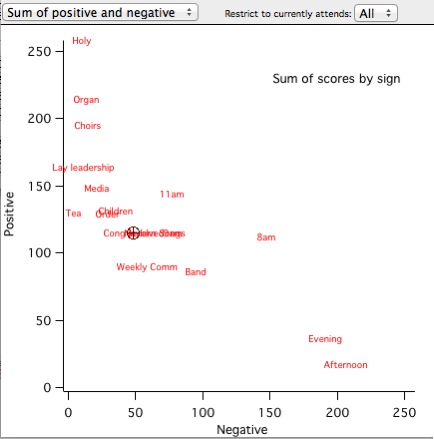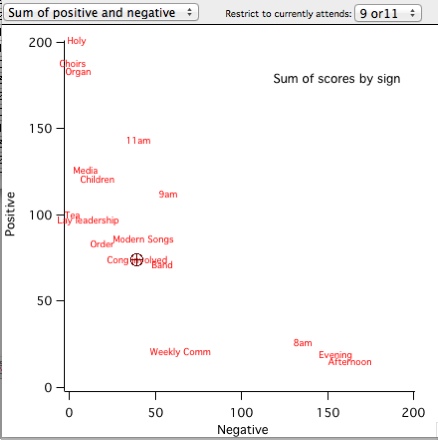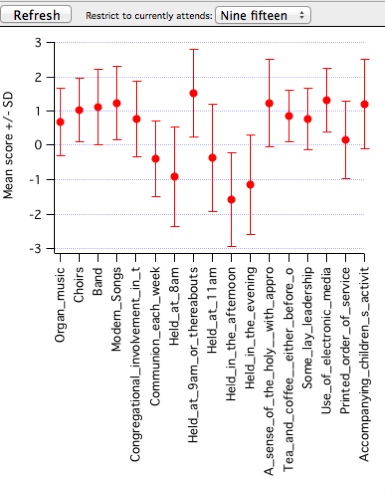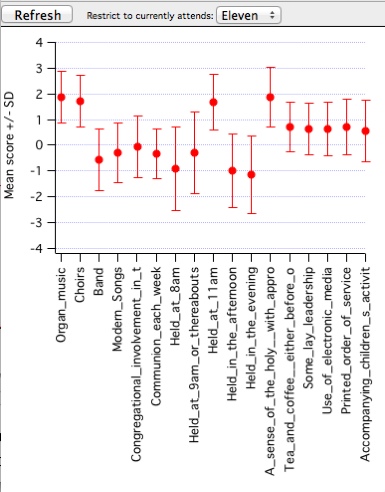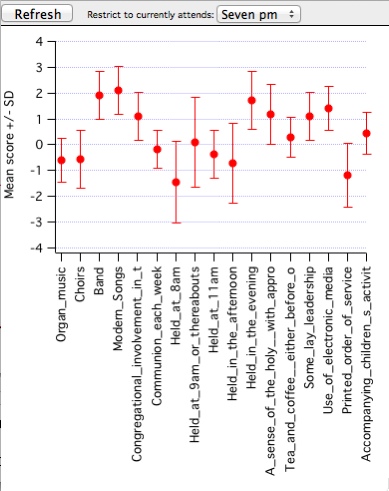|
Size: 4763
Comment: Update content
|
Size: 4950
Comment:
|
| Deletions are marked like this. | Additions are marked like this. |
| Line 25: | Line 25: |
| ||<^> Another way to look at diversity is to look at the survey means separated by current attendance. Of particular relevance are the differences between 9:15 and 11. Both value their time highly, but there are differences for the music questions, congregational involvement, children, and "A sense of the holy".||8am.<<BR>>{{attachment:SurveyMeans8.jpg}}<<BR>> 9:15 <<BR>>{{attachment:SurveyMeans9.jpg}}<<BR>> 11am.<<BR>> {{attachment:SurveyMeans11.jpg}}<<BR>> 7pm. <<BR>>{{attachment:SurveyMeans7.jpg}} || | ||<^> Another way to look at diversity is to look at the survey means separated by current attendance. Of particular relevance are the differences between 9:15 and 11. Both value their time highly, but there are differences for the music questions, congregational involvement, children, and "A sense of the holy". These plots also show that most respondents are very happy with the services that they attend, with the peculiar characteristics of each service rating highly with those who attend it. ||8am.<<BR>>{{attachment:SurveyMeans8.jpg}}<<BR>> 9:15 <<BR>>{{attachment:SurveyMeans9.jpg}}<<BR>> 11am.<<BR>> {{attachment:SurveyMeans11.jpg}}<<BR>> 7pm. <<BR>>{{attachment:SurveyMeans7.jpg}} || |
Survey on worship services 2015
ChurchCouncil is always considering the number, style and timing of worship services. It was suggested at the congregational meeting in March that Council again canvas the congregation on the question of reducing the number of services. In response to this request, concil composed a survey. The survey focused on examining the diversity of members' worship style preferences, to see if combining of services is possible. Questions concerning which services to combine and at what times, are not yet being considered.
The survey was available in paper form available at church or here, or on the web using this link.
1. Analysis of numerical answers
The following graphs show the results of the numerical questions. We received 157 surveys, made up of the following attendees. Some people attend more than one time.
38 |
Eight am |
52 |
Nine fifteen |
75 |
Eleven |
11 |
Seven pm |
19 |
other worship occasions |
The first plot shows the average and standard deviation of the various questions."A sense of the holy" is the top performer. There may be different interpretations of what this means, and the spread of values is large, but it is clearly important to many people. Encouragingly, many of the features that are sometimes seen as contentious have mainly positive responses, including organ and choir, use of electronic media, lay leadership, and the inclusion of children. |
|
The 'sense of the holy' histogram shows this. The heights of the bars show the number of surveys that gave each score for this question. |
|
It is also apparent from the averages plot that the worship time questions have large spreads. The plot to measure diversity of answers is shown opposite. Each question has a position on the graph, vertically the number of +3 ("only if..") answers, and horizontally the number of -3 ("not if..") answers. The overlapping questions are Modern songs & Lay leadership at 12 +3 answers. |
|
This is confirmed by looking at the histogram for those questions, for example the 11am time slot shown opposite, with 13 "not if.."s (-3) and 21 "only if.."s(+3). |
|
If we restrict this histogram to those who currently attend 9:15 or 11 (127 respondents), we find 20 (16% of the combined 9:15 and 11 congregations or 27% of the 11am congregations) who will only come at 11am (+3 for "Held at 11am") and 4 (3.5%) who will never come at 11 (-3 for the same question). |
|
An alternative analysis is to sum the positive and negative scores for each question, shown opposite. Again, worship times dominate the points furthest from the axes, that is, the most contentious questions. Others such as band and modern songs appear more significant, showing a large diversity of opinion, but without the extreme views that the time questions generated. |
|
If this analysis is restricted to those currently attending 9:15 or 11 only, the plot opposite results. Evening, 8am and afternoon are commonly rejected (close to the negative axis), choirs and the organ are commonly accepted (close to the vertical axis) but there are significant positive and negative scores for both 9am and 11am. |
|
Another way to look at diversity is to look at the survey means separated by current attendance. Of particular relevance are the differences between 9:15 and 11. Both value their time highly, but there are differences for the music questions, congregational involvement, children, and "A sense of the holy". These plots also show that most respondents are very happy with the services that they attend, with the peculiar characteristics of each service rating highly with those who attend it. |
8am. |
Analysis by DavidMorgan. Comments and questions welcome.
2. Analysis of the "free form" questions
This is being undertaken by JulieHall, and will be available for the August Congregational meeting
 The Glen Waverley Uniting Church PSALTER
The Glen Waverley Uniting Church PSALTER